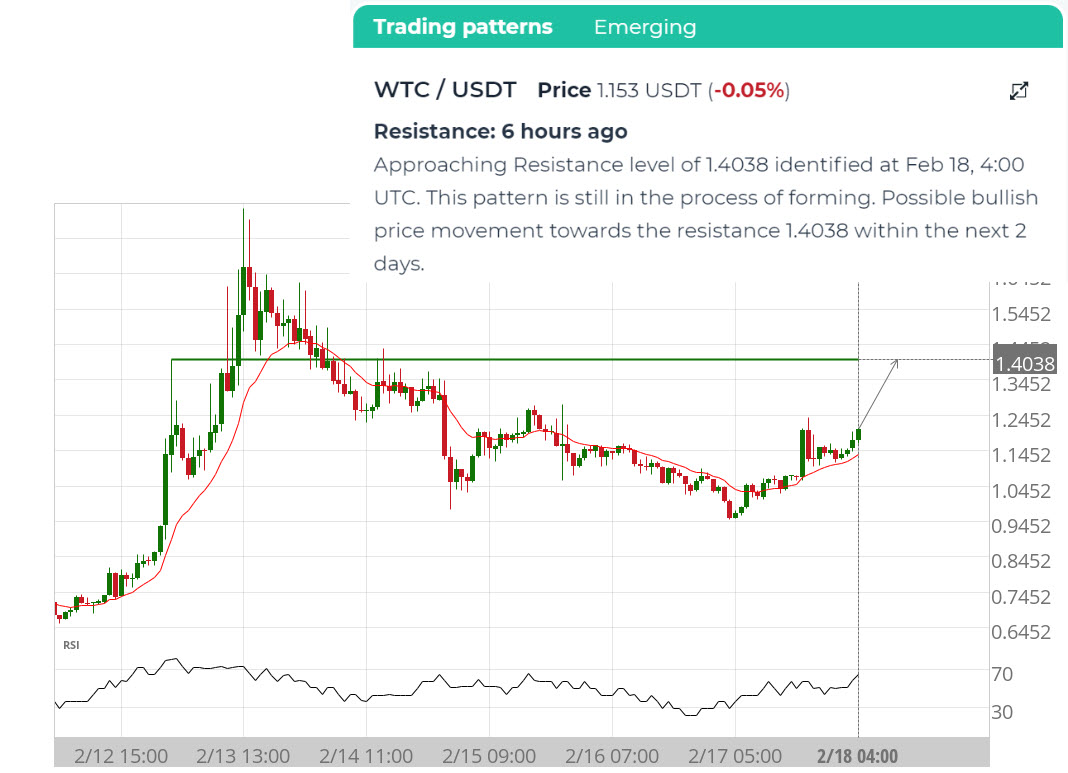How to trade resistance breakout and approach
How to trade resistance breakout and approach
Trading resistance and support levels is one of those KISS (Keep It Simple Stupid) opportunities that occur often. And they’re ideal for beginner traders. (watch 3 min video below).
Key levels (horizontal support and resistance) are pillars of technical analysis because these are areas where a lot of trading action happens!
Now, you could look at thousands of charts across multiple time intervals to identify support and resistance levels, or you can use our automated chart pattern recognition to save a ton of time.
Let’s take a look at some of recent examples of trade setups, which have achieved about 75% success rate in backtests.
There are three ways to trade resistance levels:
(1) Trading resistance approach.
Prices tend to retest support and resistance levels, until broken. Thus, traders can Buy when a coin price is approaching Resistance (as in the example below), and Sell when approaching Support.

(2) Trading resistance breakout.
If the price breaks through a key level, it tends to continue in its path for a while. Thus, traders would Buy breakouts through Resistance level (example below), and Sell breakouts through Support levels.

Which breakouts should be acted upon? Should a trader wait for a second opportunity (retracement)? The short answers are: 1) all, 2) no. A breakout should be acted upon immediately; waiting for a retracement, will diminish profitability, and you may very well miss the entire price move.
Is volume a good confirmation of breakouts? Astute traders have observed that with upward breakouts (through resistance), less volume is preferred (contrary to popular belief) while with downward breakouts (through support), more volume is preferred.
Failures happen. Breakouts can fail in any pattern; some more than others. Remember that a breakout is a signal that prices are beginning to trend, either upward or downward. As noted earlier, key level (resistance and support) breakouts and approaches have very high (~ 75%) success rates.
(3) Trade support bounce.
Another possible setup is to wait for the price to enter the Support zone and Buy it then, since most of the time it will bounce off the Support level. Vice versa, traders can wait for the price to enter the Resistance zone and Sell (or short) it then, since it’s most likely to bounce back down.
Resistance trend line now becomes the price target.
Importantly, it’s advisable to place these trades in the direction of the prevailing trend. In the case below, price is in an uptrend (Channel Up) and is likely to bounce off of support and resume upward trajectory.

Keep an eye on your time intervals. altFINS pattern detection works with four time intervals (15 min, 1h, 4h, 1d). The trade setups work with all time intervals with approximately same winning rates (~75%).
Also, keep these trades on for the length of one trade pattern, or until it reached the target profit or Stop Loss level. In the description, altFINS indicates how long is the pattern valid for.
Read more on identifying and trading chart patterns in our knowledge base and tutorial.
Risk management – Stop Loss and trade size. In all of these setups, traders should use Stop Loss orders to manage their downside risk, in case the trade goes against us, as it often will. Trading is about probabilities and even though these setups have a high win rate, one must be prepared to minimize losses on the trades that go bust. If Stop Loss order types are not supported by they exchange, at least set up a price alert (see video). Also, trade size should be such that you never risk losing more than 2% of your total equity. Keeping the trade size small allows the trader to setup a wider Stop Loss, which gives the trade more room and time to complete with success. Setting Stop Loss levels too tight can often result in getting knocked out of a trade prematurely.
Disclaimer: This content is for informational purposes only, you should not construe any such information or other material as investment, financial, or other advice. There are risks associated with investing in cryptocurrencies. Loss of principal is possible.
1 Comment
George Papazov May 17, 2021
Thank you Richard for this beautiful post. I learn many things from the article. The types of trades are really great. This will helps people and traders in many ways.